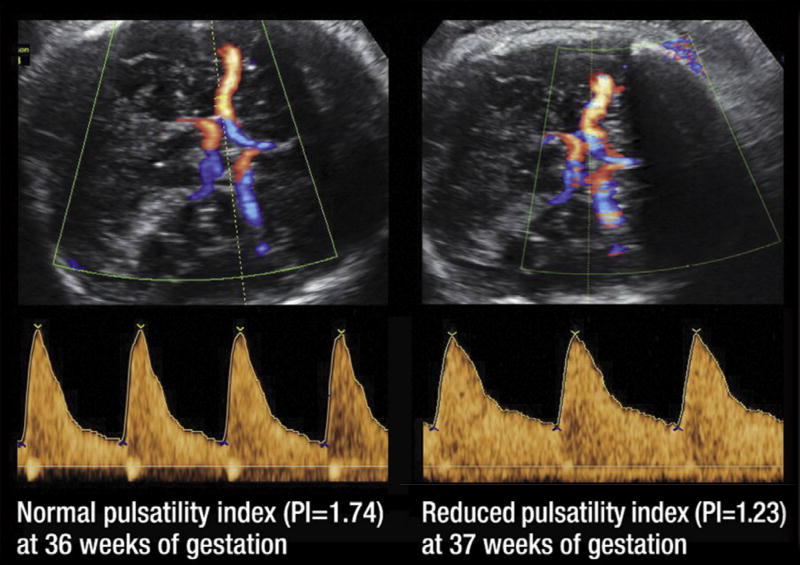On the Cover
Doppler velocimetry of the middle cerebral artery (MCA) is a method to assess impedance/resistance to flow in the fetal brain circulation. Vasodilatation of the MCA is considered to reflect a compensatory phenomenon often referred to as the “brain sparing effect.” In this issue of AJOG, 3 articles address the value of the MCA pulsatility index and the ratio between such index and the umbilical artery pulsatility index (also called cerebroplacental ratio) to assess the likelihood of admission to the newborn intensive care unit and neonatal complications in small-for-gestational-age fetuses.1,2 A review addresses the value of the cerebroplacental ratio in obstetrics.3 These 3 articles also build on previous publications of the Prospective Observational Trial to Optimize Pediatric Health in IUGR (PORTO) Study,4,5 and other publications.6–8
The color Doppler images on this page and on the cover of this issue show the Circle of Willis, a circulatory anastomosis supplying blood to the brain and surrounding structures. The sample volume of the pulsed Doppler is on the MCA, shown in red in both images. Each of the sepia waveforms across the bottom (the spectral Doppler of the MCA) represents a cardiac cycle. The vertical axis is Doppler shift, proportional to blood velocity. The horizontal axis represents time.
Shown in the image on the left is the pulsatility index of 1.74 at 34 weeks of gestation (within normal range). In contrast, the fetus on the right has increased diastolic velocities of the MCA, and the pulsatility index is 1.23. A reduced pulsatility index reflects vasodilation of the MCA. This is an indirect manifestation of hypoxemia, as reported in studies correlating results of the MCA pulsatility index and pH and blood gases obtained by cordocentesis.9
Figure 1.
Color Doppler of the circle of Willis and spectral Doppler waveform of the middle cerebral artery (normal and abnormal). The middle cerebral artery pulsatility index is part of the calculation of the cerebral placental ratio.
Acknowledgments
Funding: This research was supported, in part, by the Perinatology Research Branch, Program for Perinatal Research and Obstetrics, Division of Intramural Research, Eunice Kennedy Shriver National Institute of Child Health and Human Development, National Institutes of Health, U.S. Department of Health and Human Services (NICHD/NIH/DHHS) and, in part, with Federal funds from NICHD/NIH/DHHS under Contract No. HHSN275201300006C.
References
- 1.Khalil AA, Morales-Rosello J, Morlando M, et al. Is fetal cerebroplacental ratio an independent predictor of intrapartum fetal compromise and neonatal unit admission? Am J Obstet Gynecol. 2015;213:54.e1–10. doi: 10.1016/j.ajog.2014.10.024. [DOI] [PubMed] [Google Scholar]
- 2.Khalil AA, Morales-Rosello J, Elsaddig M, et al. The association between fetal Doppler and admission to neonatal unit at term. Am J Obstet Gynecol. 2015;213:57.e1–7. doi: 10.1016/j.ajog.2014.10.013. [DOI] [PubMed] [Google Scholar]
- 3.DeVore GR. The importance of the cerebroplacental ratio in the evaluation of fetal well-being in SGA and AGA fetuses. Am J Obstet Gynecol. 2015;213:5–15. doi: 10.1016/j.ajog.2015.05.024. [DOI] [PubMed] [Google Scholar]
- 4.Flood K, Unterscheider J, Daly S, et al. The role of brain sparing in the prediction of adverse outcomes in intrauterine growth restriction: results of the multicenter PORTO Study. Am J Obstet Gynecol. 2014;211:288.e1–5. doi: 10.1016/j.ajog.2014.05.008. [DOI] [PubMed] [Google Scholar]
- 5.Unterscheider J, Daly S, Geary MP, et al. Predictable progressive Doppler deterioration in IUGR: does it really exist? Am J Obstet Gynecol. 2013;209:539.e1–7. doi: 10.1016/j.ajog.2013.08.039. [DOI] [PubMed] [Google Scholar]
- 6.Wladimiroff JW, vd Winjngaard JA, Degani S, Noordam MJ, van Eyck J, Tonge HM. Cerebral and umbilical arterial blood flow velocity waveforms in normal and growth-retarded pregnancies. Obstet Gynecol. 1987;69:705–9. [PubMed] [Google Scholar]
- 7.Mari G, Moise KJ, Jr, Deter RL, Kirshon B, Carpenter RJ, Jr, Huhta JC. Doppler assessment of the pulsatility index in the cerebral circulation of the human fetus. Am J Obstet Gynecol. 1989;160:698–703. doi: 10.1016/s0002-9378(89)80063-8. [DOI] [PubMed] [Google Scholar]
- 8.Bahado-Singh RO, Kovanci E, Jeffres A, et al. The Doppler cerebroplacental ratio and perinatal outcome in intrauterine growth restriction. Am J Obstet Gynecol. 1999;180(3 Pt 1):750–6. doi: 10.1016/s0002-9378(99)70283-8. [DOI] [PubMed] [Google Scholar]
- 9.Vyas S, Nicolaides KH, Bower S, Campbell S. Middle cerebral artery flow velocity waveforms in fetal hypoxaemia. Br J Obstet Gynaecol. 1990;97:797–803. doi: 10.1111/j.1471-0528.1990.tb02573.x. [DOI] [PubMed] [Google Scholar]



